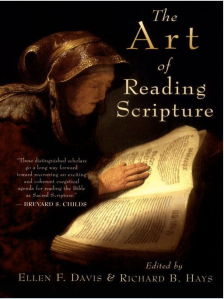 Reading the Bible as Christian Scripture is both simple and complex. It is complex because—like any art, craft, or sport—it requires a range of tools and much practice in order to reach a level of significant competency. Mastery remains elusive, and not only because Scripture’s subject matter (God) escapes human comprehension. But reading Scripture is also simple. An ordinary reader can go far toward deep understanding, without special training or even a Bible study guide, because the most basic task of reading Scripture is paying close attention to words.
Reading the Bible as Christian Scripture is both simple and complex. It is complex because—like any art, craft, or sport—it requires a range of tools and much practice in order to reach a level of significant competency. Mastery remains elusive, and not only because Scripture’s subject matter (God) escapes human comprehension. But reading Scripture is also simple. An ordinary reader can go far toward deep understanding, without special training or even a Bible study guide, because the most basic task of reading Scripture is paying close attention to words.
I feel privileged to have spent the last fifteen years learning from some of the cleverest, wisest, kindest, and most sophisticated readers of Christian Scripture I know of, and they each have contributed to the habits and skills I now bring to reading Scripture. So in the spirit of my teachers’ generosity, here are
Ten Practical Tips for Studying the Bible as Christian Scripture:
1. Read for yourself. There is no substitute for doing your own reading. Read the words on the page, ignoring chapter breaks, subject headings, and any commentary. Puzzle over what you don’t understand without resorting to external resources. It’s okay not to understand everything. It is better to learn the words and let difficulties stand than to have them quickly resolved.
2. Take notes. Tracking what you discover is easier if you write it down. Numbers 3-9 below suggest some categories for organizing notes. Taking notes isn’t essential for learning to read the Bible well, but writing aids thinking and memory, so note-taking rewards the effort.
3. Read whole books. Each book of the Bible is a cohesive document, and so books are good units for study. Like other stories and letters, biblical books want to be read from start to finish without interruptions. Start reading the book straight through—in one sitting, if possible. Look for structure and recurring themes. Reading whole books is like taking a good, long, memorizing look at the picture on the jigsaw puzzle box so you know what the assembled puzzle should look like. Finding structure and recurring themes may take several all-the-way-through readings. I have found listening to audio recordings of biblical books effective for this purpose.
4. Read small portions closely. If reading whole books is like viewing the picture on the box of the puzzle, then reading small portions closely is like looking carefully at each piece to analyze how it fits into the whole. One can’t look at an entire mural, hear a whole symphony, or read a novel all at once. Readers must select portions small enough for our ability to focus. Close reading catalogs the details in a short passage for how they contribute to the purpose of the whole book. Ask, “What would the larger image lose if this smaller section were missing?” The best reading toggles between wide-angle and close-up, fostering both depth and breadth of understanding.
5. Pay special attention to God. Obvious, but worth saying: The Bible is mainly about God, and ostensibly, Christians read the Bible in order to know God better. Every last word about God matters—how God is named, how often God appears, whom God addresses, what God says, what God does, when God isn’t mentioned, and when and where God surprises human beings. God’s many names throughout the Bible also matter. “God,” “the LORD,” “Holy One of Israel,” “Holy Spirit,” “Son of God,” “Son of Man,” “Jesus,” and “Christ” each illuminate God’s identity in particular ways. Listing names for God and ways God appears is a useful exercise, but even a mental note makes a fine start.
6. Note beginnings and endings. “In the beginning, God created the heavens and the earth” (Gen 1:1). In this first verse of the Bible, both the biblical story and the whole sphere of human existence begin with God. These convictions frame the entire Bible—this world belongs to God, and so all reflection about the world’s proper order has a theological shape. A biblical book’s beginning often provides its framework. Endings frequently draw the reader into living well in this world. The oldest manuscripts of Mark’s Gospel end abruptly with the fear and silence of the women who first saw the empty tomb, but the last words of dialogue send them and the disciples—and the reader by extension—ahead to Galilee to find and follow the risen Jesus (Mark 16:1-8). Revelation’s last verses draw the reader into expectant waiting for Jesus’ return, and into the grace-filled life that Jesus makes possible (Rev 22:20-21). So beginnings and endings merit close attention.
7. Attend to context. Every portion of Scripture was written at a particular time and place. Some books note such information clearly, or provide the setting of the story. For example, Isaiah specifies the time of his vision as, “In the year that King Uzziah died” (Isaiah 6:1), which gives the event a narrative framework readers can find in 2 Kings 15. The story of Luke’s Gospel begins, “In the days of Herod, King of Judea…” Paul addresses his letters to particular churches in specified cities, often naming particular people in those churches. Exodus begins with the narrator’s note that “there arose a new king over Egypt who did not know Joseph,” which does not specify a historically identifiable place and time, but does indicate an important change in situation for Jacob’s family in Egypt. Contextual markers paint the backdrop against which the books make the best sense.
8. Notice characters. The main characters don’t hide—Abraham, Jacob, Joseph, Moses, David, Jesus, Peter, and Paul. But many fascinating and important actors get little air time, and some aren’t even named. For example, without the deception of an obscure, enterprising Canaanite woman named Tamar, the line of Judah—which eventually leads to David and Jesus—would have died out in Genesis 38. Without two wily midwives named Shiphrah and Puah, his unnamed mother, sister, and an Egyptian princess, Moses would never have survived his infancy (Exod 1-2). Without Mary’s receptive generosity and Joseph’s obedient listening to God, Jesus would never have been conceived (Luke 1:38) or have survived childhood (Matt 1:18-24; 2:13-21). Neither the Syrophoenician/Canaanite woman who answers Jesus so cleverly (Matt 15:21-28 // Mark 7:24-30), nor the Samaritan woman at the well (John 4:1-41), nor the marvelously insightful man born blind (John 9) have names in their stories, but each provides unique insight into Jesus’ identity. In the book of Jonah, nearly everything is animate. A storm, a great fish, the sea, a ship, a “sultry east wind,” the “beasts of Nineveh,” a plant, and a very hungry caterpillar all have active roles in a drama displaying God’s wide mercy. In the Bible, every character matters, whether named, unnamed, human, animal, vegetable, mineral, force of nature, or human-made object.
9. Watch for repeated, interesting, or strange words. Although variance in translation may obscure some connections, it is still possible to gain significant insight into Scripture by taking note of key words. A concordance can help, but one can do such work simply by reading and comparing passages. Words repeated in a single passage often signal an important point of emphasis. For example, the word “ground” recurs in Genesis 2-3 eight times:
1. “there was no man to till the ground” (2:5)
2. “a mist went up from the earth and watered the whole face of the ground” (2:6)
3. “the Lord God formed the human being of dust from the ground” (2:7)
4. “out of the ground the Lord God caused to grow every tree” (2:9)
5. “out of the ground the Lord God formed every beast of the field and every bird of the air” (2:19)
6. “cursed is the ground because of you” (3:17)
7. “till you return to the ground” (3:19)
8. “to till the ground from which he was taken” (3:23)
The “ground” plays an important role in the creation of all life, and so the curse on the ground shows the magnitude of human disobedience. Similarly, God’s promise, after the flood, “never again to curse the ground because of human beings” (Gen 8:21) spells the beginning of creation’s redemption. So repeated words are important, and a single word that appears in two apparently disconnected stories can reveal an unexpected connection. Every word matters.
10. Share. Reading Scripture within the church’s tradition is like learning a language. Reading the Bible for oneself using the above suggestions is like intentional language study (learning grammar, building vocabulary, etc.). Discussing and interpreting the Bible with others, reading commentaries, and studying historical interpretation of Scripture are a bit like practicing a language one is in the process of learning (actually speaking the language). Like learning a language well, becoming an adept reader of Christian Scripture involves both intentional study and practice.
For me, these practices elicit profound joy in discovering the character of the God to whose revelation Scripture bears witness. I hope they do the same for you.


Pingback: Tuesday Reading Roundup | (Mostly) Consolation
Excellent points!—-and very helpful by extension to the task of reading and understanding poetry! Thank you so much!
LikeLike
Teri, thank you for the kind words! I am glad you found the post helpful. One of my Bible teachers once used Billy Collins’s poem “Introduction to Poetry” to help us think our way into how to pay attention the words we were about to read, and I found it not only delightful, but instructive. So I think good reading of poetry also has some important lessons to teach folks attempting to read Scripture with care. Thanks for reading and sharing your thoughts!
LikeLike
I just have to stop and say that Moses’, Aaron’s, and Miriam’s mother is named: Jochebed. (Exodus 6:20)
LikeLike
Rachael, good eye! Thanks for weighing in. That is a totally fair comment. I wasn’t looking at the genealogy of Moses and Aaron when I wrote about the unnamed characters, or the later stories where Miriam also is named. I was looking at the story in Exodus 2 where none of Moses’ family is named. I think both stories are important. So readers should ask, “Why, when it seems that Moses’ parents’ names were known to someone involved in the writing of Exodus, were they left unnamed in the story of Moses birth, whereas the midwives were named?” I think it’s important to pay attention to that level of detail.
LikeLike
Hi Celia! I agree, it’s important to pay attention to that level of detail. It strikes me that if Moses’ genealogical information had gone first, the fact that Moses was going to do something big would have been a foregone conclusion. By starting with “a man of the house of Levi took a wife of the daughters of [the house of] Levi”, the text brings out the unexpectedness of God’s working important events through ordinary people.
LikeLiked by 1 person
Celia,
It is important for me to focus on God when we read the Bible. I always forget to focus on God. When I read the Bible, I try to find verses that can give me strength, power, and faith, but neglecting to learn God. What you write reminds me. I always need reminds. Thank you!
LikeLike